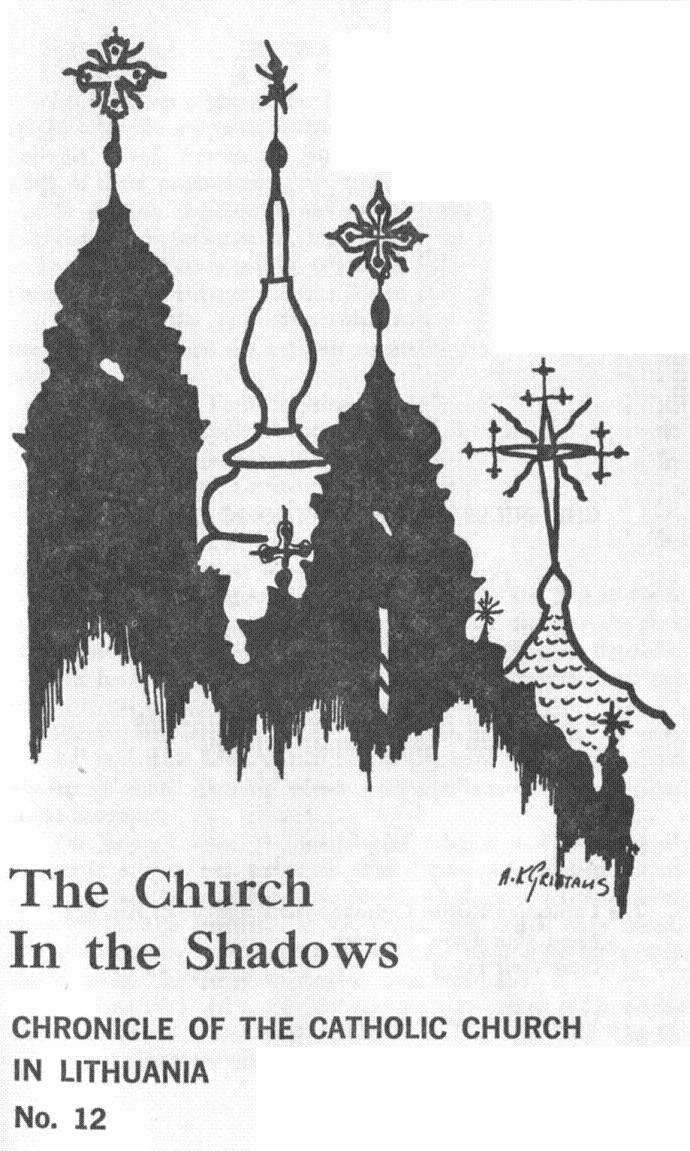
CHRONICLE OF THE CATHOLIC CHURCH IN LITHUANIA
Translation of Authentic First-Hand Reports from Soviet-Occupied Lithuania
Published by
The Lithuanian Roman Catholic Priests' League of America 64-09 56th Road, Maspeth New York 11378
United States of America
©The Lithuanian Roman Catholic Priests' League
INTRODUCTION
In 1940, when the Soviet Union occupied Lithuania by force, 85.5% of the country's more than 3 million inhabitants were Roman Catholic, 4.5% Protestant, 7.3% Jewish, 2.5% Orthodox, and 0.2% of other persuasions.
In the two archdioceses and four dioceses were: 708 churches, 314 chapels, 73 monasteries, 85 convents, three archbishops, nine bishops, 1271 diocesan priests, 580 monks, of whom 168 were priests. Four seminaries had 470 students. There were 950 nuns.
Nuns cared for 35 kindergartens, 10 orphanages, 25 homes for the aged, two hospitals, a youth center, and an institute for the deaf-mute.
There were 18 Catholic primary schools and the same number of Catholic high schools. Religion was taught in all public schools.
Catholic organizations numbered about 800,000 members. In 1935, there were 28 Catholic magazines and newspapers, with a total circulation of 7,000,000.
On June 15, 1940, the Red Army marched into Lithuania; the independent government was replaced by a puppet regime.
On July 14-15, rigged elections were staged. On July 21, with the Red Army surrounding the assembly house, the new People's Diet "unanimously" declared Lithuania a Soviet Socialist Republic.
On June 25, 1940, the Church was declared separate from the state, and the representative of the Holy See was expelled.
Parish lands were confiscated, clergy salaries and pensions were cut off, and their savings confiscated. Churches were deprived of support. Catholic printing plants were confiscated, and religious books destroyed.
On June 28, 1940, the teaching of religion and recitation of prayers in schools was forbidden. The University's Department of Theology and Philosophy was abolished, and all private schools were nationalized. The seminaries at Vilkaviškis and Telšiai were closed, and the seminary at Kaunas was permitted to operate on a very limited scale. The clergy were spied upon constantly.
On June 15, 1941, 34,260 Lithuanians were packed off in cattle-cars to undisclosed points in the Soviet Union. After World War II, the mass deportations resumed and continued until 1953.
Vincentas Borisevičius, Bishop of Telšiai, was arrested on February 3, 1946, and condemned to death after a secret trial. Before year's end, his auxiliary, Bishop Pranas Ramanauskas, was also arrested and deported to Siberia. Bishop Teofilius Matulionis of Kaišiadorys and Archbishop Mečislovas Reinys of Vilnius were deported to a Siberian labor camp. Archbishop Reinys perished in prison at Vladimir, November 8, 1953. By 1947, Lithuania was left with a single bishop, Kazimieras Paltarokas, of Panevėžys. He died in 1958.
In 1947, the last convents and monasteries were closed, their communities dispersed, and all monastic institutions were outlawed.
After Stalin's death in 1953, there was a slight improvement in the religious situation. Bishops Matulionis and Ramanauskas were allowed to return to Lithuania, but not to minister to their dioceses or to communicate with the clergy or laity.
Bishop Ramanauskas died in 1959, and Archbishop Matulionis in 1963.
In 1955, two new bishops were appointed by Rome and consecrated: Julijonas Steponavičius and Petras Maželis. Steponavičius has never been permitted to administer his diocese.
Bishop Vincentas Sladkevičius, consecrated in 1957, is also under severe government restrictions. In 1965, Monsignor Juozas Labukas-Matulaitis was consecrated in Rome to head the Archdiocese of Kaunas and the Diocese of Vilkaviškis.
Relaxation of pressure on religious believers soon revealed that the Lithuanian people were still deeply religious. It was decided in the mid-fifties to resume the attack. The principal means of attack would be unlimited moral pressure, since physical terror seemed only to strengthen and unify the faithful.
In 1972, the Chronicle of the Catholic Church in Lithuania, clandestinely published in that country, began to reach the free world at irregular intervals. Primarily intended to keep Catholics in Lithuania informed of the situation of the Church there, these Lithuanian samizdat also serve as a constant appeal to the free world not to forget the plight of a people struggling against overwhelming odds to defend their religious beliefs and to regain their basic
human rights.
Rev. Casimir Pugevičius
Vice President
Lithuanian Roman Catholic
Priests' League of America
On March 19, 1972, the first issue of the Chronicle of the Catholic Church in Lithuania very hesitantly made its appearance, with no way of estimating how much interest it would meet with at home or abroad. The atheistic government accused it of wrong-doing and by massive searches and arrests tried to stifle it.






